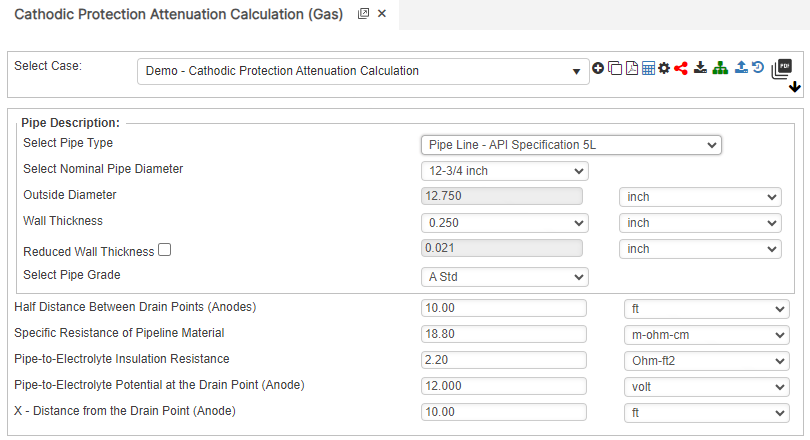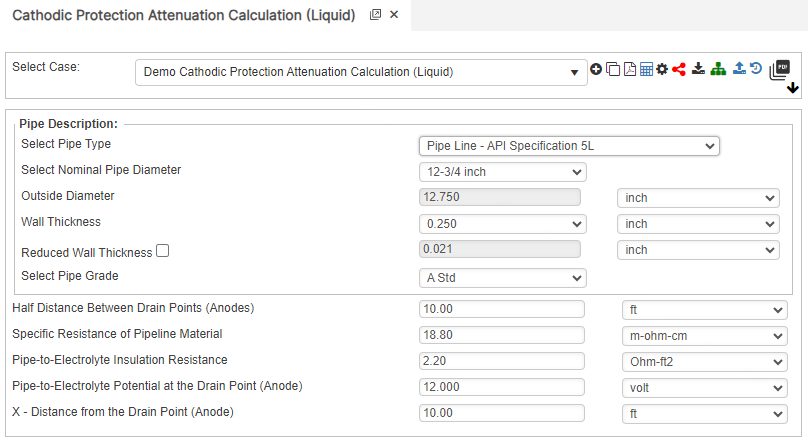Introduction
Where long distances are covered by impressed current systems, voltage drops occur along the structure in a reduction fashion of voltages and currents. Reductions can be significant depending on the current demand and voltage drops. This may require additional cathodic protection for the pipeline system.
R_L=\frac{\rho}{A_w}\,or \,R_L =4L\frac{\rho}{\pi(D_o-D_i)}\~\R_T=\frac{R_0}{\pi D_o}\~\R_K=\sqrt{R_LR_T}\~\\alpha=\sqrt{\frac{R_L}{R_T}}
R_L=\frac{\rho}{A_w}\,or \,R_L =4L\frac{\rho}{\pi(D_o-D_i)}\\~\\R_T=\frac{R_0}{\pi D_o}\\~\\R_K=\sqrt{R_LR_T}\\~\\\alpha=\sqrt{\frac{R_L}{R_T}}E_x=E_0 \sinh \alpha X-R_KI_0\sinh \alpha X \~\ E_0=E_x \sinh \alpha X-R_KI_x\sinh \alpha X\~\ I_x=I_o \cosh \alpha X-\frac{E_0}{R_K}\sinh \alpha X \~\ I_0=I_x \cosh \alpha X-\frac{E_x}{R_K}\sinh \alpha X
E_x=E_0 \sinh \alpha X-R_KI_0\sinh \alpha X \\~\\ E_0=E_x \sinh \alpha X-R_KI_x\sinh \alpha X\\~\\ I_x=I_o \cosh \alpha X-\frac{E_0}{R_K}\sinh \alpha X \\~\\ I_0=I_x \cosh \alpha X-\frac{E_x}{R_K}\sinh \alpha XWhere:
𝑅𝐿 — Linear Electrical Resistance of the Section of the Pipeline(ohm/m)
𝑅𝑇 — Leakage or Transverse Resistance of the Section of the Pipeline(ohm/m)
𝑅𝐾 — Characteristic Resistance of the Section of the Pipeline(Ohms)
𝛼 — Attenuation Constant of the Section of the Pipeline(Ohms)
𝑅0 — Pipe to Electrolyte Insulation Resistance(Ohms)
𝜌 — Specific Resistance of the Pipeline Material(Ohms)
𝐿 — Half Distance between Drain Points(anodes)(m)
𝐷𝑜 — External Diameter of the Pipeline(m)
𝐷𝑖 — Internal Diameter of the Pipeline(m)
𝐴𝑤 — Pipe Cross Sectional Area(in-2)
𝐸0 — Pipe to Electrolyte Potential at the Drain Point(Anode)(V)
𝐸𝑥 — Pipe to Electrolyte Potential at the Distance of X from the Drain Point(V)
𝐼0 — Current Flowing onto the Pipe at the Drain Point(Anode)(amp)
𝐼𝑥 — Current Flowing onto the Pipe at Distance X from the Drain Point(Anode)(amp)
For typical pipeline with multiple drain points (anodes) with uniform spacing of 2L the potential and current are given: E_x=E_0 \frac{\cosh\alpha (L-X)}{\sinh \alpha L}\~\I_x=I_0 \frac{\sinh\alpha (L-X)}{\sinh \alpha L}
E_x=E_0 \frac{\cosh\alpha (L-X)}{\sinh \alpha L}\\~\\I_x=I_0 \frac{\sinh\alpha (L-X)}{\sinh \alpha L}Case Guide
Part 1: Create Case
- Select the Cathodic Protection Module Attenuation Calculation application from the Cathodic Protection Module
- To create a new case, click the “Add Case” button
- Enter Case Name, Location, Date and any necessary notes.
- Fill out all required parameters.
- Make sure the values you are inputting are in the correct units.
- Click the CALCULATE button to overview results.
Input Parameters
- Pipe Outside Diameter (in)
- Pipe Wall Thickness (in)
- Half Distance between Drain Points (Anodes) (ft)
- Specific Resistance of Pipeline Material (m-ohm-cm)
- Pipe-to-Electrolyte Insulation Resistance (ohm-ft2)
- Pipe-to-Electrolyte Potential at the Drain Point (volt)
- X – Distance from the Drain Point (Anode) (ft)


Part 2: Outputs/Reports
- If you need to modify an input parameter, click the CALCULATE button after the change.
- To SAVE, fill out all required case details then click the SAVE button.
- To rename an existing file, click the SAVE As button. Provide all case info then click SAVE.
- To generate a REPORT, click the REPORT button.
- The user may export the Case/Report by clicking the Export to Excel icon.
- To delete a case, click the DELETE icon near the top of the widget.
Results
- Linear Electrical Resistance of the Pipeline Section (ohm/ft)
- Leakage/Transverse Resistance of the Pipeline Section (ohm-ft)
- Characteristic Resistance of the Pipeline Section (ohm)
- Attenuation Constant of the Pipeline Section (1/ft)
- Pipe-to-Electrolyte Potential at the Distance of X from the Drain Point (volt)




References
- NACE Standard Practices 0169 – Latest Edition “Control of Corrosion on Underground or Submerged Metallic Piping Systems”
- Uhlig’s Corrosion Handbook (2nd Edition) Edited by: Revie, R. Winston © 2000 John Wiley & Sons
- ISO 15589-2 Petroleum and Natural gas Industries Cathodic Protection Pipeline Transportation Systems
- Pipeline Corrosion and Cathodic Protection, Third Edition, Gulf Publishing Company
FAQ
-
ASME B31G Original/Modified and RSTRENG?
ASME B31.G Original and Modified (0.85) are Level 1 assessment along with most other metal loss calculations that are limited to pits and short lengths of pitting clusters. RSTRENG is a Level 2 metal loss calculation; however, it is not limited just to pits, but most lengths of pitting i.e., 2500 mm (100 inches) using interaction rules that is not uncommon on some pipelines. Check Out
-
Preventative and Corrective Measures to Control Corrosion Pitting?
A corrosion rate needed to set the re-inspection interval, reassess the performance metrics and their current applicability, plus to ensure the assumptions made are correct. At each direct examination where corrosion pitting is found, the operator should measure and record each pitting cluster. Check Out
-
Estimating Internal Corrosion Rates?
Internal corrosion is most likely to occur where water first accumulates. Predicting these locations of water accumulation serve as a method for prioritizing local examinations. Predicting where water first accumulates requires knowledge about the multiphase flow behavior in the pipe requiring certain data. Check Out
-
Estimating External Corrosion Rates?
All corrosion defects found during each direct examination should be measured, documented, and remediated as needed. At each excavation, the pipeline operator should measure and record generic environmental characteristics (such as soil resistivity, hydrology, drainage etc.). Check Out
